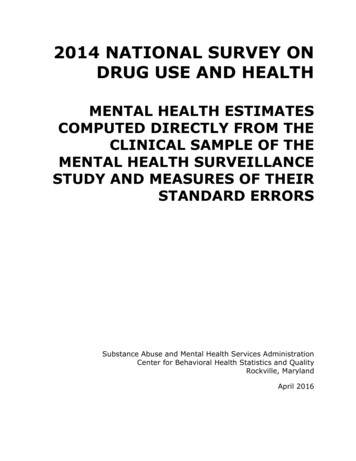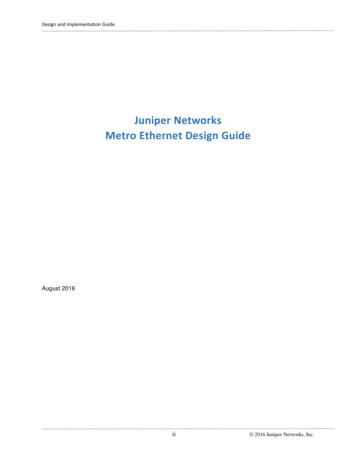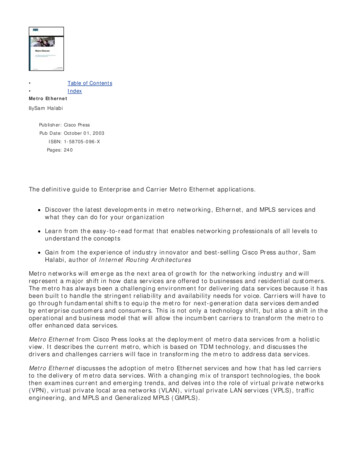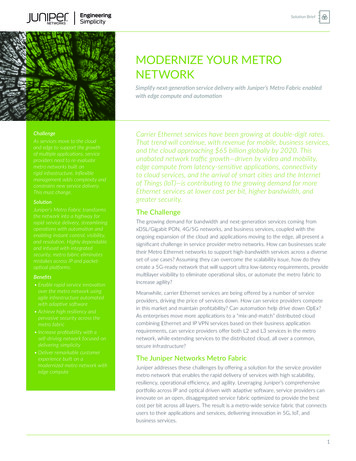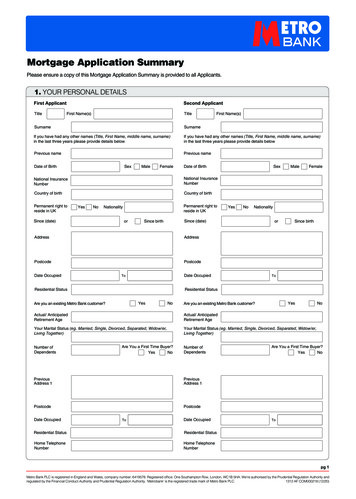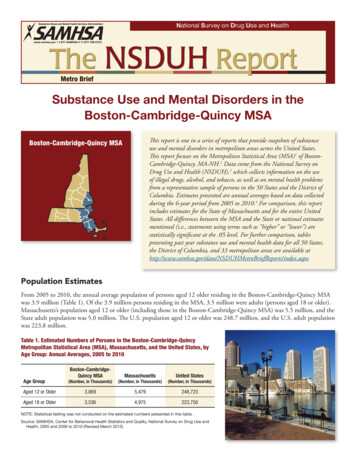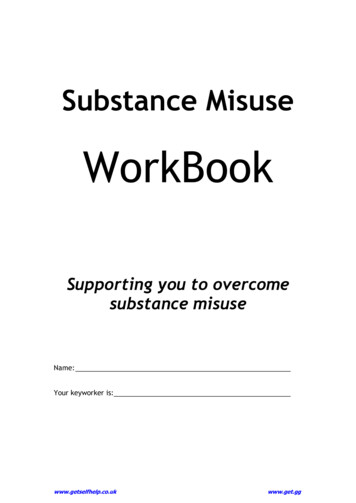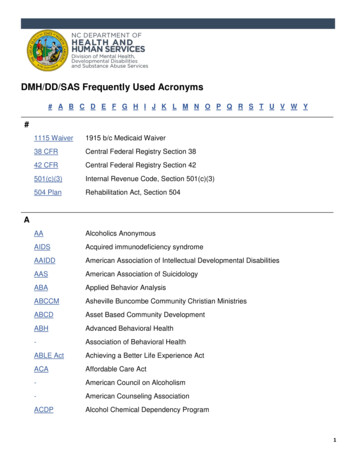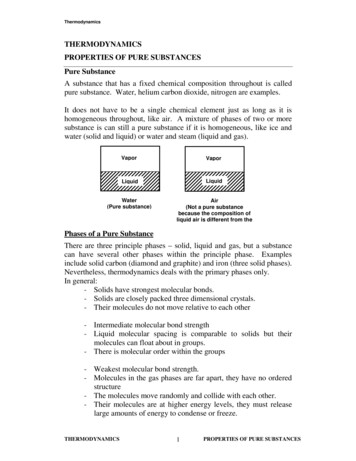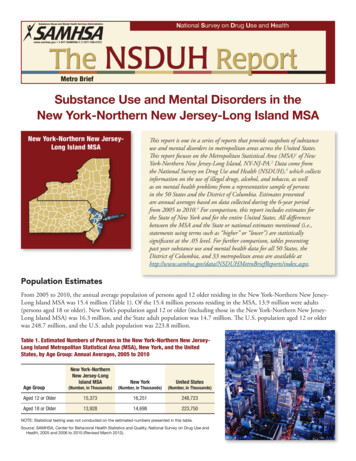
Transcription
Metro BriefSubstance Use and Mental Disorders in theNew York-Northern New Jersey-Long Island MSANew York-Northern New JerseyLong Island MSAThis report is one in a series of reports that provide snapshots of substanceuse and mental disorders in metropolitan areas across the United States.This report focuses on the Metropolitan Statistical Area (MSA)1 of NewYork-Northern New Jersey-Long Island, NY-NJ-PA.2 Data come fromthe National Survey on Drug Use and Health (NSDUH),3 which collectsinformation on the use of illegal drugs, alcohol, and tobacco, as wellas on mental health problems from a representative sample of personsin the 50 States and the District of Columbia. Estimates presentedare annual averages based on data collected during the 6-year periodfrom 2005 to 2010.4 For comparison, this report includes estimates forthe State of New York and for the entire United States. All differencesbetween the MSA and the State or national estimates mentioned (i.e.,statements using terms such as “higher” or “lower”) are statisticallysignificant at the .05 level. For further comparison, tables presentingpast year substance use and mental health data for all 50 States, theDistrict of Columbia, and 33 metropolitan areas are available s/index.aspx.Population EstimatesFrom 2005 to 2010, the annual average population of persons aged 12 older residing in the New York-Northern New JerseyLong Island MSA was 15.4 million (Table 1). Of the 15.4 million persons residing in the MSA, 13.9 million were adults(persons aged 18 or older). New York’s population aged 12 or older (including those in the New York-Northern New JerseyLong Island MSA) was 16.3 million, and the State adult population was 14.7 million. The U.S. population aged 12 or olderwas 248.7 million, and the U.S. adult population was 223.8 million.Table 1. Estimated Numbers of Persons in the New York-Northern New JerseyLong Island Metropolitan Statistical Area (MSA), New York, and the UnitedStates, by Age Group: Annual Averages, 2005 to 2010Age GroupNew York-NorthernNew Jersey-LongIsland MSANew YorkUnited States(Number, in Thousands)(Number, in Thousands)(Number, in Thousands)Aged 12 or Older15,37316,251248,723Aged 18 or Older13,92814,698223,750NOTE: Statistical testing was not conducted on the estimated numbers presented in this table.Source: SAMHSA, Center for Behavioral Health Statistics and Quality, National Survey on Drug Use andHealth, 2005 and 2006 to 2010 (Revised March 2012).
THE NSDUH REPORT: Metro BriefNew York-Northern New Jersey-Long Island MSAIllicit Drug UseIn the New York-Northern New Jersey-Long Island MSA, an annual average of 2.1 million persons aged 12 orolder used any illicit drug in the past year.5 This represents 13.9 percent of the MSA population and is lowerthan the rate for the State of New York (15.5 percent) but is similar to the national rate (14.7 percent) (Figure1). The rate of marijuana use in the past year was 10.4 percent, which was also lower than the rate in NewYork. The rate of nonmedical use of prescription-type pain relievers was lower in the New York-Northern NewJersey-Long Island MSA than in the State of New York or the Nation as a whole (3.7 percent in the MSA vs.4.2 percent in New York and 4.9 percent in the Nation).Figure 1. Past Year Use of Selected Illicit Drugs for the New York-Northern New Jersey-Long Island MetropolitanStatistical Area (MSA), New York, and the United States among Persons Aged 12 or Older: Annual Averages,2005 to 20102015.516Percent13.9a14.712.212New YorkNorthern NewJersey-Long IslandMSA10.710.4a8New York3.7a,b44.24.9United States0Any Illicit DrugMarijuanaPrescription-TypePain Relievers (Nonmedical)NOTE: For additional data, please see the tables available at index.aspx.abDifference between New York-Northern New Jersey-Long Island MSA estimate and New York estimate is statistically significant at the .05 level.Difference between New York-Northern New Jersey-Long Island MSA estimate and United States estimate is statistically significant at the .05 level.Source: SAMHSA, Center for Behavioral Health Statistics and Quality, National Survey on Drug Use and Health, 2005 and 2006 to 2010 (RevisedMarch 2012).2
THE NSDUH REPORT: Metro BriefNew York-Northern New Jersey-Long Island MSASubstance Use or Mental DisordersIn the New York-Northern New Jersey-Long Island MSA, 1.2 million persons aged 12 or older wereclassified as having a substance use disorder in the past year (Figure 2).6 The corresponding rate (7.5 percent)was lower than the rate in New York but similar to the national rate. Among adults aged 18 or older inthe New York-Northern New Jersey-Long Island MSA, 6.2 percent (850,000 adults) experienced a majordepressive episode in the past year, which was similar to the rates in the State of New York and the Nation asa whole.7Figure 2. Past Year Substance Use Disorder and Major Depressive Episode for the New York-Northern NewJersey-Long Island Metropolitan Statistical Area (MSA), New York, and the United States among Persons Aged12 or Older (Except as Noted): Annual Averages, 2005 to 201012108.6Percent89.07.5a,b6.266.66.6New YorkNorthern NewJersey-Long IslandMSANew York4United States20Substance Use DisorderMajor Depressive Episode (Aged 18 or Older)NOTE: For additional data, please see the tables available at index.aspx.abDifference between New York-Northern New Jersey-Long Island MSA estimate and New York estimate is statistically significant at the .05 level.Difference between New York-Northern New Jersey-Long Island MSA estimate and United States estimate is statistically significant at the .05 level.Source: SAMHSA, Center for Behavioral Health Statistics and Quality, National Survey on Drug Use and Health, 2005 and 2006 to 2010 (RevisedMarch 2012).3
THE NSDUH REPORT: Metro BriefNew York-Northern New Jersey-Long Island MSACigarette and Binge Alcohol UseIn the New York-Northern New Jersey-Long Island MSA, 20.4 percent of persons aged 12 or older smokedcigarettes in the past month, and 22.0 percent of persons aged 12 or older participated in binge alcohol useat least once in the past month (Figure 3).8 These rates were lower than the rates in the State of New York andthe Nation.Figure 3. Past Month Cigarette and Binge Alcohol Use for the New York-Northern New Jersey-Long IslandMetropolitan Statistical Area (MSA), New York, and the United States among Persons Aged 12 or Older: AnnualAverages, 2005 to ew YorkNorthern NewJersey-Long IslandMSA10New YorkUnited States50Cigarette UseBinge Alcohol UseNOTE: For additional data, please see the tables available at index.aspx.abDifference between New York-Northern New Jersey-Long Island MSA estimate and New York estimate is statistically significant at the .05 level.Difference between New York-Northern New Jersey-Long Island MSA estimate and United States estimate is statistically significant at the .05 level.Source: SAMHSA, Center for Behavioral Health Statistics and Quality, National Survey on Drug Use and Health, 2005 and 2006 to 2010 (RevisedMarch 2012).4
THE NSDUH REPORT: Metro BriefNew York-Northern New Jersey-Long Island MSAEnd Notes1. MSAs are geographical entities used by Federal agencies to collect, analyze, and publish statistical data. These areasare defined and updated periodically by the Office of Management and Budget (OMB). MSAs defined in this reportare based on updates made by OMB on December 1, 2009, to reflect Census Bureau population estimates for July1, 2007, and July 1, 2008. More details are provided at assets/bulletins/b10-02.pdf (Executive Office of the President, Office of Management and Budget, 2009).2. The New York-Northern New Jersey-Long Island MSA consists of Bergen County, NJ; Essex County, NJ; HudsonCounty, NJ; Hunterdon County, NJ; Middlesex County, NJ; Monmouth County, NJ; Morris County, NJ; OceanCounty, NJ; Passaic County, NJ; Somerset County, NJ; Sussex County, NJ; Union County, NJ; Bronx County,NY; Kings County, NY; Nassau County, NY; New York County, NY; Putnam County, NY; Queens County, NY;Richmond County, NY; Rockland County, NY; Suffolk County, NY; Westchester County, NY; and Pike County, PA.3. NSDUH is an annual survey of the U.S. civilian noninstitutional population aged 12 or older in the 50 States andthe District of Columbia. The survey collects data by administering questionnaires to a representative sample ofthe population through face-to-face interviews at the respondent’s place of residence. NSDUH is sponsored by theSubstance Abuse and Mental Health Services Administration (SAMHSA) and is managed by SAMHSA’s Center forBehavioral Health Statistics and Quality (CBHSQ). For more information, see the 2010 NSDUH national findingsreport at ults.htm (CBHSQ, 2011a).4. All estimates shown in this report and the detailed tables used the corrected 2006-2010 data files that were updatedto account for errors found in Pennsylvania (2006-2010) and Maryland (2008-2009). The erroneous Pennsylvaniaand Maryland data were removed and the remaining cases were reweighted in the years noted. No correctionswere needed for the 2005 data file. These estimates are based solely the weighted sample for each area (i.e., directestimates) and are weighted to represent the civilian noninstitutional population at the MSA, State, and nationallevels based on the selection probabilities (at each stage of selection), nonresponse adjustments, and adjustments toState- and national-level population estimates from the U.S. Census Bureau. However, no special adjustments wereapplied to adjust these weights to Census population estimates for the New York-Northern New Jersey-Long IslandMSA. See Section A.3.3 of Appendix A in the 2010 NSDUH national findings report at ults.htm (CBHSQ, 2011a).5. Illicit drugs include marijuana/hashish, cocaine (including crack), heroin, hallucinogens, inhalants, or prescriptiontype psychotherapeutics used nonmedically. These estimates do not include data from new methamphetamine itemsadded in 2005 and 2006. See Section B.4.8 of Appendix B in the 2008 NSDUH national findings report at ts.htm (Office of Applied Studies [now CBHSQ], 2009).6. Substance use disorder is defined as dependence on or abuse of illicit drugs or alcohol based on definitions foundin the fourth edition of the Diagnostic and Statistical Manual of Mental Disorders (DSM-IV; American PsychiatricAssociation, 1994). See Section B.4.2 of Appendix B in the 2010 NSDUH national findings report at ults.htm (CBHSQ, 2011a).7. Major depressive episode is defined in DSM-IV (American Psychiatric Association, 1994) as a period of at least2 weeks when a person experienced a depressed mood or loss of interest or pleasure in daily activities and had amajority of specified depression symptoms. See Section B.4.4 of Appendix B in the 2010 NSDUH mental healthfindings report at http://www.samhsa.gov/data/NSDUH/2k10MH Findings/2k10MHResults.htm (CBHSQ,2011b).8. Binge alcohol use is defined as drinking five or more drinks on the same occasion (i.e., at the same time or within acouple of hours of each other) on at least 1 day in the 30 days prior to the survey.5
THE NSDUH REPORT: Metro BriefNew York-Northern New Jersey-Long Island MSAReferencesAmerican Psychiatric Association. (1994). Diagnostic and statistical manual of mental disorders (4th ed.). Washington,DC: Author.Center for Behavioral Health Statistics and Quality. (2011a). Results from the 2010 National Survey on Drug Use andHealth: Summary of national findings (NSDUH Series H-41, HHS Publication No. SMA 11-4658). Rockville,MD: Substance Abuse and Mental Health Services Administration. Retrieved from ults.htmCenter for Behavioral Health Statistics and Quality. (2011b). Results from the 2010 National Survey on Drug Use andHealth: Mental health findings (NSDUH Series H-42, HHS Publication No. SMA 11-4667). Rockville, MD:Substance Abuse and Mental Health Services Administration. Retrieved from http://www.samhsa.gov/data/NSDUH/2k10MH Findings/2k10MHResults.htmExecutive Office of the President, Office of Management and Budget. (2009, December 1). Update of statistical areadefinitions and guidance on their uses (OMB Bulletin No. 10-02). Washington, DC: Author. Retrieved from assets/bulletins/b10-02.pdfOffice of Applied Studies. (2009). Results from the 2008 National Survey on Drug Use and Health: National findings(NSDUH Series H-36, HHS Publication No. SMA 09-4434). Rockville, MD: Substance Abuse and Mental HealthServices Administration. Retrieved from ts.htmU.S. DEPARTMENT OF HEALTH AND HUMAN SERVICESSubstance Abuse and Mental Health Services AdministrationCenter for Behavioral Health Statistics and Qualitywww.samhsa.gov/data6
the National Survey on Drug Use and Health (NSDUH),3 which collects information on the use of illegal drugs, alcohol, and tobacco, as well as on mental health problems from a representative sample of persons in the 50 States and the District of Columbia. Estimates presented are annual
